
Can Draft Capital Help Predict Tight End Success?
In our 63-part analytical series, “Does It Matter?”, we next wanted to look into the intriguing question of whether a Tight End’s
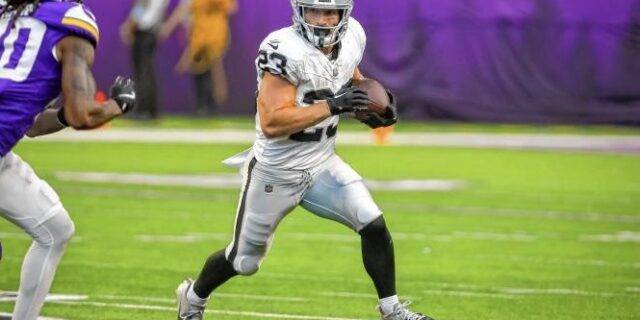

For part 26 of our “Does It Matter?” series, we explored whether a college running back’s best all-purpose (AP) yardage season can predict their success in the NFL. To do this, we analyzed the top 50 fantasy football finishers since 2003. Here are all of our findings:
For this analysis, we looked at the top 50 fantasy football finishers for each season since 2003 using PPR (points per reception) fantasy football scores. Throughout this article, you will see the term “Bottom 10”. This is defined as those finishing 41st to 50th each season. Further, the acronym “AP yardage” is “All-Purpose yardage,” which is the sum of rushing and receiving yards. The college RB’s AP yardages we used was simply their top season. In our theory, this gives insight into what their ceiling is.
Why the top 50? The reason we chose the top 50 is to find a happy medium. We don’t want to go further than the top 50 and start getting close to the fringe roster members whom obviously are not going to score top 10. These players could therefore just weigh the data. On the other hand, We want to compare the worst to the best still. Comparing the top 10 to the 11th place finisher, or an average number that takes into account the 11th place finisher, doesn’t satisfy our personal itch to try to find trends.
For the first phase of our analysis, we created an averages chart which reflects RB’s best college AP yardage seasons, while also breaking it down into different Fantasy Football finisher groups. Those groups are as follows:
The findings were quite revealing. Each top 10 NFL RB finishers (average) top college AP yardage season consistently was higher compared to those finishing in the 31st to 50th range. In all 21 seasons, the Top 10 finishers consistently had higher best college AP yardage seasons than the 31st to 50th finishers.
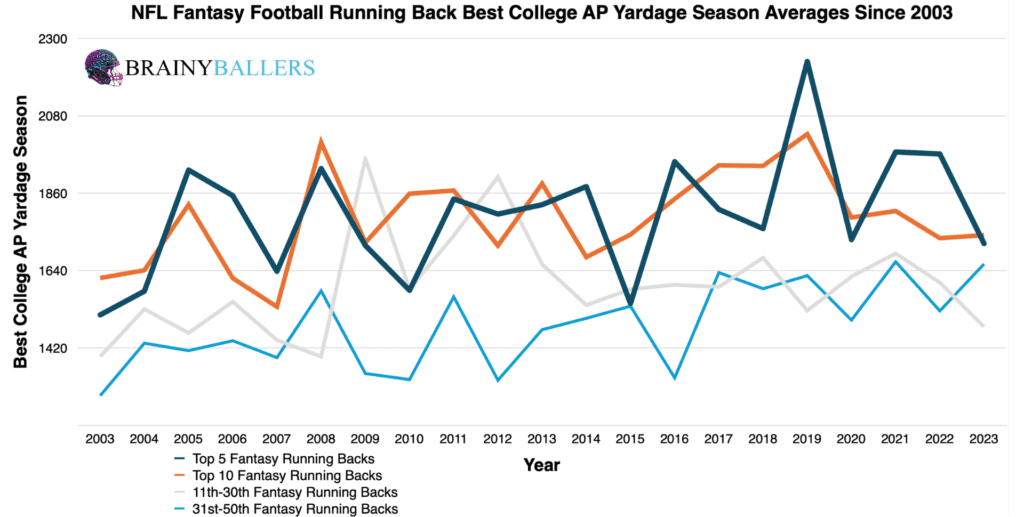
Next, we charted the top 10 finishers since 2003 by segmenting their best college AP yardage season into 50-yard increments (rounded to 50). This segmentation revealed a similar pattern:
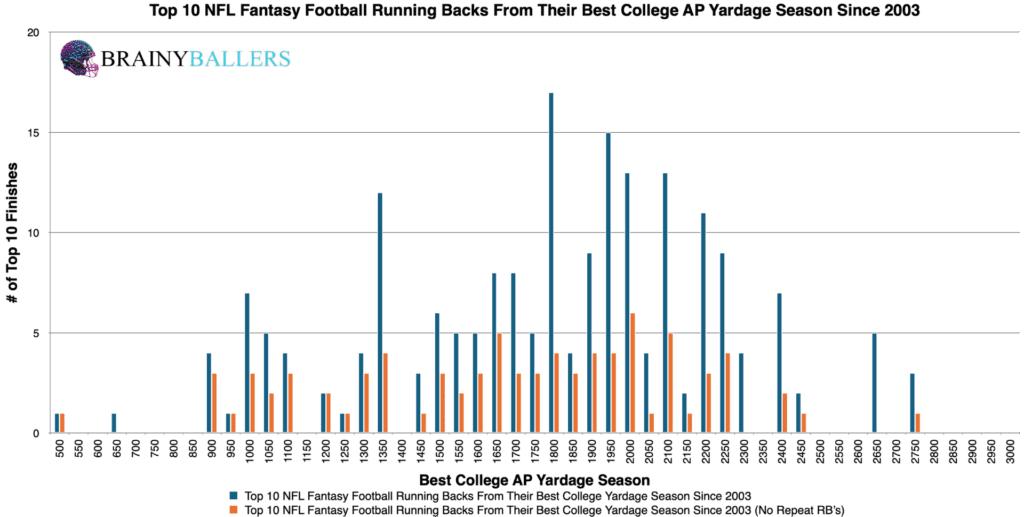
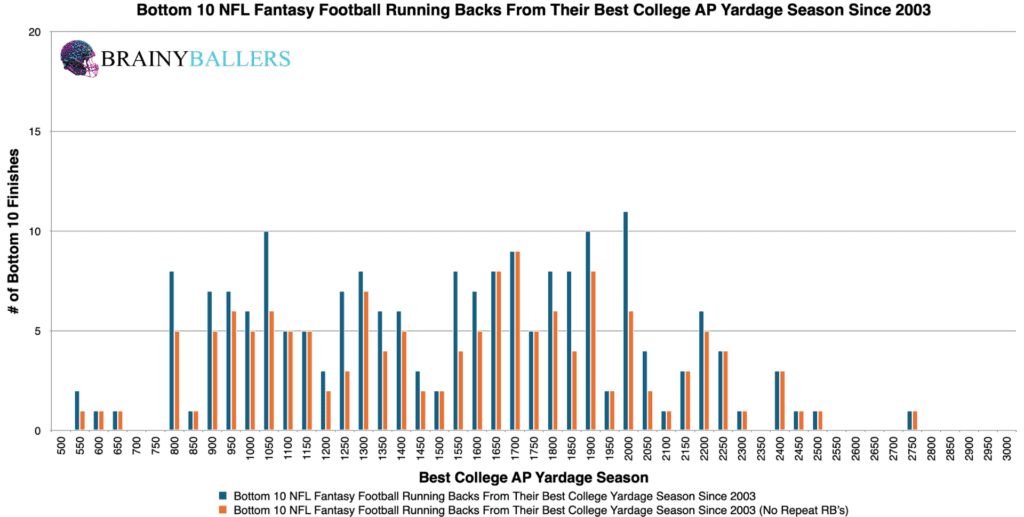
Our main goal was to identify the threshold for peak performance among NFL running backs. To achieve this, we made a differences chart to compare each yardage and the next 200 yards. Essentially, the top 10 to bottom 10 differences across all possible 200 yard spans. The chart’s desired outcome is a negative number for unique differences (Orange) and a positive number for non-unique differences (Blue). This would indicate the desired consistent top level performances we are hoping for.
Findings: The 1,600-yard mark and above emerged as a potential threshold for peak performance. This yardage range consistently demonstrated the highest differences, indicating it as a possible performance threshold. Therefore, we are going to look deeper into the 1,600 AP yardage and above threshold next to try to verify whether it is the optimal range.
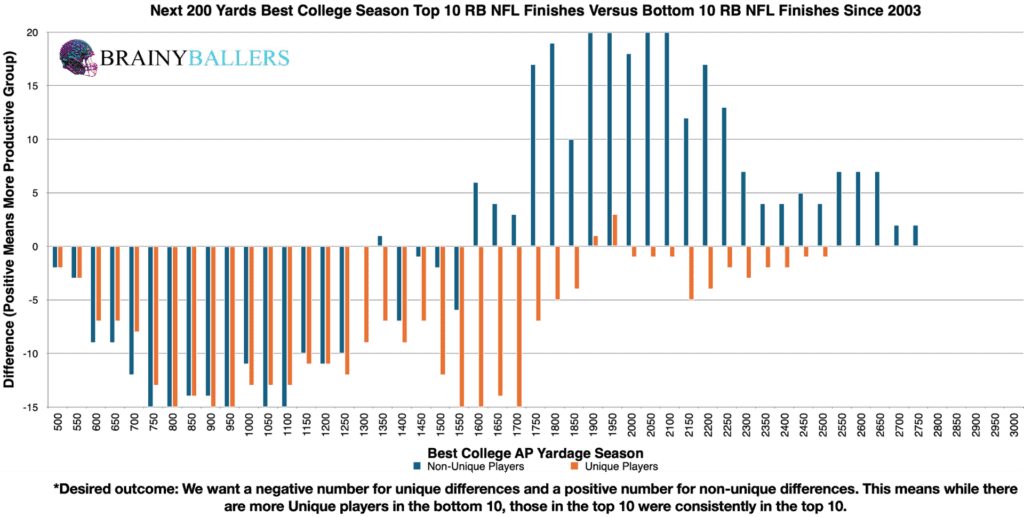
We then moved forward by comparing this specific yardage threshold against all RBs who finished in the bottom 10 since 2003. For this, we evaluated 199 RBs, noting if their best college All-Purpose (AP) yardage season reached 1,600 yards or more. Out of these 199 RBs, 93 hit the 1,600-yard mark, accounting for 46.7% and setting our baseline for comparison to the top 10. We now will compare this to the top 10 to attempt to find whether we found an average RB’s best AP yardage college season, or if we found a top-performing RB’s best AP yardage college season.
If more than 46.7% occurs in the top 10, then we found a top-performing RB’s best AP yardage college season. From 2003-2023, 144 of 201 top 10 finishers fell within the 1,600-yard range, representing 71.6%. This was a significant 24.9% increase over the baseline, strongly suggesting 1,600 yards could be a legitimate threshold. Since these are all rounded to the nearest 50 yards, its important to note that 1,576 yards would be the threshold, if 1,600 yards is next verified as the threshold.
To have precision, we used our spreadsheet to make quick range adjustments to accurately identify the highest performing yardage. From that, we noticed that altering the threshold to 1,450 AP yardage and above yielded a 25.3% higher rate of top 10 appearances compared to the bottom 10, outperforming the 1,600-yard threshold. With rounded numbers, 1,426 AP yardage and above will be the subject of our analysis going forward, and our optimal threshold for this statistic.
Due to these findings, top AP yardage seasons could play a factor in our Star-Predictor Score (SPS) model. Since 450 AP yards is the lowest seen since 2003 in the top 10, this will be the critical value for the SPS. The Star-Predictor Score (SPS) is a scouting tool designed to maximize investment potential and reduce risks when drafting rookies in Fantasy Football. It is proven to have a higher accuracy than draft capital alone to predict fantasy success. The SPS includes 13 to 17 metrics, with the exact number varying by the player’s position. All these metrics are pre-NFL, and some are invented by us, providing a complete analysis of a player’s analytical profiles. The SPS gained widespread notoriety for its high accuracy, having made it on Barstool and The Pat McAfee Show. The SPS can be found here.

Our findings were backed by strong regression testing results:
This Pearson Value indicates strong correlation between top AP yardage seasons and future fantasy points. We are hoping for a minimum of 0.1, or an inverse correlation maximum of -0.1 when we study world-class athletes as we are. For reference to something that everyone acknowledges matters in prospect scouting, and to show the accompanying Pearson value, RB draft capital prevailed a -0.234 Pearson value.
To find trends in the best college AP yards for the top 10, the 11-40th place finishers, and the bottom 10 finishers over various decades, we broke down all the numbers into the 2 most recent decades. A noticeable trend is the 9.5% decrease in the rate where our optimal range appeared in the top 10 more than in the bottom 10 compared to earlier decades. This suggests that the strength of the college AP yardage as a predictor has diminished slightly in recent years.
| 2004-2013 | |||
| Top 10 | 11 through 40 | Bottom 10 | |
| All count | 94 | 275 | 95 |
| All 1,450 and above | 73 | 160 | 45 |
| % (Optimal Range/all) | 77.7% | 58.2% | 47.4% |
| 2014-2023 | |||
| Top 10 | 11 through 40 | Bottom 10 | |
| All count | 97 | 285 | 94 |
| All 1,450 and above | 78 | 189 | 56 |
| % (Optimal Range/all) | 80.4% | 66.3% | 59.6% |
What 3 metrics matter the most when scouting a rookie Quarterback? What threshold should Quarterbacks achieve within those metrics to be considered an elite prospect? How much should you value those stats above all other stats? Couldn't answer those questions? Rest easy, we have it handled for you. That's what this chart answers. Sort by importance and/or filter by position. Unlock by signing up with the links provided. $9.99/Year or $24.99 Lifetime access. Cancel anytime.
Our analysis supports the theory that a college RB’s best AP yardage season can be a predictive indicator of NFL success. After our thorough analysis, the 1,426 AP yardage best college season threshold emerged as the highest producing range for top-performing NFL RBs. Our findings were also validated by regression testing. Therefore, for those assessing future NFL RB talent, it does matter to consider a player’s best college AP yardage season as a significant factor.
Our series has always sought to push the boundaries of sports analytics. This latest installment reaffirms our commitment to uncovering the hidden dynamics that define the game. Every Saturday, we’ll dive into intriguing questions, bust myths, and settle debates with thorough analysis. We welcome your input. Therefore, please leave comments or reach out with topics you’re eager to see dissected. Premium Analytics subscribers get priority. All of our research can be found on our Analytics Page. Up next on our agenda for Part 27 of “Does It Matter?” is an examination of RB Draft Capital: Does it matter? If so, what’s the Draft Capital threshold necessary for RB success? Mark your calendars; every Saturday we shed light on the topics that matter to you.


BrainyBallers Buy-Hold-Sell Chart (All Players)
Get Your Order 100% Refunded By Predicting The Next SuperBowl Winner!

In our 63-part analytical series, “Does It Matter?”, we next wanted to look into the intriguing question of whether a Tight End’s
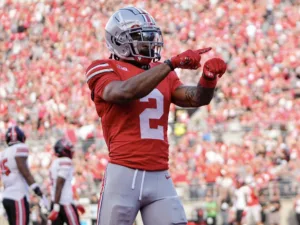
For our 61 part “Does It Matter?” series, we looked into whether a Wide Receiver’s College Yards After Catch per Reception (YAC/Rec)

In part 60 of our “Does It Matter?” series, we dove into the question of whether a college Wide Receiver’s career Average
© 2023 BrainyBallers | All Rights Reserved